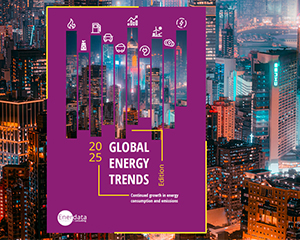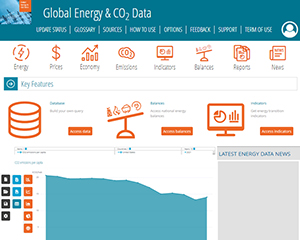総エネルギー消費量
2024年の世界のエネルギー消費量は2.2%増加し、2010~2019年までの期間よりも速いペースで増加しています。
+4%
中国のエネルギー消費量は大幅に増加し、現在では世界のエネルギー消費量の27%を占めています。
2024年の世界のエネルギー消費量は2.2%増加し、2010~2019年までの期間よりも速いペースで増加しています。
世界のエネルギー消費量は2024年に2.2%増加し、過去の2010~2019年の傾向(年間+1.5%)を上回り、**特にBRICS(+3%)**は2024年に世界のエネルギー消費量の43%を占め、力強い経済成長を記録しました。特に成長が急速だったのは中国(+4%。2023年に7%回復し、2010~2019年の平均に戻る)、インド(+5%。2010~2019年と同水準)、インドネシア(+6%。過去の2倍)、ベトナム(+9%)、ロシア(+2%)、ブラジル(+3%)です。
一方、OECD諸国では、経済成長が緩やかまたは緩やかな中、エネルギー消費の伸び率は鈍化し(平均で+1%)、非常に異なる傾向を示しました。米国(+1%)、韓国(+2%)、オーストラリア(+1%)、トルコ(+6%)では増加しましたが、EU、メキシコ、カナダでは横ばい、日本では1%減少しました。中東では若干増加し(イランの5%増加はサウジアラビアの1%減少によって部分的に相殺)、アフリカでは2.5%増加しました(エジプトでは5%増加)。
国別内訳 (Mtoe)
世界
トレンド 1990 - 2024 - Mtoe
世界 の貿易 (2024) - Mtoe
「世界エネルギー動向」(2025年版)は、重要なエネルギーデータに関する洞察を示しています。
当社は、これらの調査結果を長期的な気候目標に照らし合わせて考察しました。
- 2050年目標の達成に向けて、さらなる努力が求められる地域とは?
- 欧州がパリ協定の目標達成に苦戦している根本的な要因とは?
- 気候変動の緩和に大きく寄与している地域とは?
Need more data? All the information presented in this energy data tool are extracted from Global Energy & CO2 Data service, the most comprehensive and up-to-date database on supply, demand, prices, indicators, and emissions, per energy sources.
このサービスについて知る


